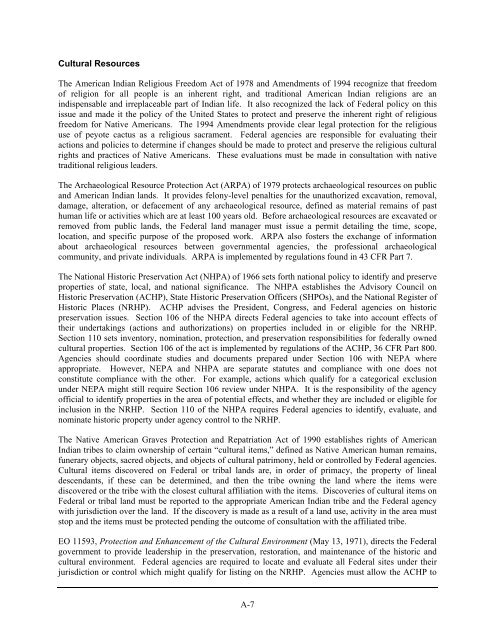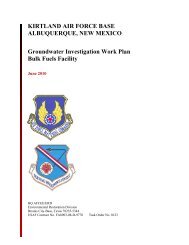Final FONSI and EA for hot cargo pad on Kirtland AFB - Kirtland Air ...
Final FONSI and EA for hot cargo pad on Kirtland AFB - Kirtland Air ...
Final FONSI and EA for hot cargo pad on Kirtland AFB - Kirtland Air ...
You also want an ePaper? Increase the reach of your titles
YUMPU automatically turns print PDFs into web optimized ePapers that Google loves.
Cultural Resources<br />
The American Indian Religious Freedom Act of 1978 <str<strong>on</strong>g>and</str<strong>on</strong>g> Amendments of 1994 recognize that freedom<br />
of religi<strong>on</strong> <str<strong>on</strong>g>for</str<strong>on</strong>g> all people is an inherent right, <str<strong>on</strong>g>and</str<strong>on</strong>g> traditi<strong>on</strong>al American Indian religi<strong>on</strong>s are an<br />
indispensable <str<strong>on</strong>g>and</str<strong>on</strong>g> irreplaceable part of Indian life. It also recognized the lack of Federal policy <strong>on</strong> this<br />
issue <str<strong>on</strong>g>and</str<strong>on</strong>g> made it the policy of the United States to protect <str<strong>on</strong>g>and</str<strong>on</strong>g> preserve the inherent right of religious<br />
freedom <str<strong>on</strong>g>for</str<strong>on</strong>g> Native Americans. The 1994 Amendments provide clear legal protecti<strong>on</strong> <str<strong>on</strong>g>for</str<strong>on</strong>g> the religious<br />
use of peyote cactus as a religious sacrament. Federal agencies are resp<strong>on</strong>sible <str<strong>on</strong>g>for</str<strong>on</strong>g> evaluating their<br />
acti<strong>on</strong>s <str<strong>on</strong>g>and</str<strong>on</strong>g> policies to determine if changes should be made to protect <str<strong>on</strong>g>and</str<strong>on</strong>g> preserve the religious cultural<br />
rights <str<strong>on</strong>g>and</str<strong>on</strong>g> practices of Native Americans. These evaluati<strong>on</strong>s must be made in c<strong>on</strong>sultati<strong>on</strong> with native<br />
traditi<strong>on</strong>al religious leaders.<br />
The Archaeological Resource Protecti<strong>on</strong> Act (ARPA) of 1979 protects archaeological resources <strong>on</strong> public<br />
<str<strong>on</strong>g>and</str<strong>on</strong>g> American Indian l<str<strong>on</strong>g>and</str<strong>on</strong>g>s. It provides fel<strong>on</strong>y-level penalties <str<strong>on</strong>g>for</str<strong>on</strong>g> the unauthorized excavati<strong>on</strong>, removal,<br />
damage, alterati<strong>on</strong>, or defacement of any archaeological resource, defined as material remains of past<br />
human life or activities which are at least 100 years old. Be<str<strong>on</strong>g>for</str<strong>on</strong>g>e archaeological resources are excavated or<br />
removed from public l<str<strong>on</strong>g>and</str<strong>on</strong>g>s, the Federal l<str<strong>on</strong>g>and</str<strong>on</strong>g> manager must issue a permit detailing the time, scope,<br />
locati<strong>on</strong>, <str<strong>on</strong>g>and</str<strong>on</strong>g> specific purpose of the proposed work. ARPA also fosters the exchange of in<str<strong>on</strong>g>for</str<strong>on</strong>g>mati<strong>on</strong><br />
about archaeological resources between governmental agencies, the professi<strong>on</strong>al archaeological<br />
community, <str<strong>on</strong>g>and</str<strong>on</strong>g> private individuals. ARPA is implemented by regulati<strong>on</strong>s found in 43 CFR Part 7.<br />
The Nati<strong>on</strong>al Historic Preservati<strong>on</strong> Act (NHPA) of 1966 sets <str<strong>on</strong>g>for</str<strong>on</strong>g>th nati<strong>on</strong>al policy to identify <str<strong>on</strong>g>and</str<strong>on</strong>g> preserve<br />
properties of state, local, <str<strong>on</strong>g>and</str<strong>on</strong>g> nati<strong>on</strong>al significance. The NHPA establishes the Advisory Council <strong>on</strong><br />
Historic Preservati<strong>on</strong> (ACHP), State Historic Preservati<strong>on</strong> Officers (SHPOs), <str<strong>on</strong>g>and</str<strong>on</strong>g> the Nati<strong>on</strong>al Register of<br />
Historic Places (NRHP). ACHP advises the President, C<strong>on</strong>gress, <str<strong>on</strong>g>and</str<strong>on</strong>g> Federal agencies <strong>on</strong> historic<br />
preservati<strong>on</strong> issues. Secti<strong>on</strong> 106 of the NHPA directs Federal agencies to take into account effects of<br />
their undertakings (acti<strong>on</strong>s <str<strong>on</strong>g>and</str<strong>on</strong>g> authorizati<strong>on</strong>s) <strong>on</strong> properties included in or eligible <str<strong>on</strong>g>for</str<strong>on</strong>g> the NRHP.<br />
Secti<strong>on</strong> 110 sets inventory, nominati<strong>on</strong>, protecti<strong>on</strong>, <str<strong>on</strong>g>and</str<strong>on</strong>g> preservati<strong>on</strong> resp<strong>on</strong>sibilities <str<strong>on</strong>g>for</str<strong>on</strong>g> federally owned<br />
cultural properties. Secti<strong>on</strong> 106 of the act is implemented by regulati<strong>on</strong>s of the ACHP, 36 CFR Part 800.<br />
Agencies should coordinate studies <str<strong>on</strong>g>and</str<strong>on</strong>g> documents prepared under Secti<strong>on</strong> 106 with NEPA where<br />
appropriate. However, NEPA <str<strong>on</strong>g>and</str<strong>on</strong>g> NHPA are separate statutes <str<strong>on</strong>g>and</str<strong>on</strong>g> compliance with <strong>on</strong>e does not<br />
c<strong>on</strong>stitute compliance with the other. For example, acti<strong>on</strong>s which qualify <str<strong>on</strong>g>for</str<strong>on</strong>g> a categorical exclusi<strong>on</strong><br />
under NEPA might still require Secti<strong>on</strong> 106 review under NHPA. It is the resp<strong>on</strong>sibility of the agency<br />
official to identify properties in the area of potential effects, <str<strong>on</strong>g>and</str<strong>on</strong>g> whether they are included or eligible <str<strong>on</strong>g>for</str<strong>on</strong>g><br />
inclusi<strong>on</strong> in the NRHP. Secti<strong>on</strong> 110 of the NHPA requires Federal agencies to identify, evaluate, <str<strong>on</strong>g>and</str<strong>on</strong>g><br />
nominate historic property under agency c<strong>on</strong>trol to the NRHP.<br />
The Native American Graves Protecti<strong>on</strong> <str<strong>on</strong>g>and</str<strong>on</strong>g> Repatriati<strong>on</strong> Act of 1990 establishes rights of American<br />
Indian tribes to claim ownership of certain “cultural items,” defined as Native American human remains,<br />
funerary objects, sacred objects, <str<strong>on</strong>g>and</str<strong>on</strong>g> objects of cultural patrim<strong>on</strong>y, held or c<strong>on</strong>trolled by Federal agencies.<br />
Cultural items discovered <strong>on</strong> Federal or tribal l<str<strong>on</strong>g>and</str<strong>on</strong>g>s are, in order of primacy, the property of lineal<br />
descendants, if these can be determined, <str<strong>on</strong>g>and</str<strong>on</strong>g> then the tribe owning the l<str<strong>on</strong>g>and</str<strong>on</strong>g> where the items were<br />
discovered or the tribe with the closest cultural affiliati<strong>on</strong> with the items. Discoveries of cultural items <strong>on</strong><br />
Federal or tribal l<str<strong>on</strong>g>and</str<strong>on</strong>g> must be reported to the appropriate American Indian tribe <str<strong>on</strong>g>and</str<strong>on</strong>g> the Federal agency<br />
with jurisdicti<strong>on</strong> over the l<str<strong>on</strong>g>and</str<strong>on</strong>g>. If the discovery is made as a result of a l<str<strong>on</strong>g>and</str<strong>on</strong>g> use, activity in the area must<br />
stop <str<strong>on</strong>g>and</str<strong>on</strong>g> the items must be protected pending the outcome of c<strong>on</strong>sultati<strong>on</strong> with the affiliated tribe.<br />
EO 11593, Protecti<strong>on</strong> <str<strong>on</strong>g>and</str<strong>on</strong>g> Enhancement of the Cultural Envir<strong>on</strong>ment (May 13, 1971), directs the Federal<br />
government to provide leadership in the preservati<strong>on</strong>, restorati<strong>on</strong>, <str<strong>on</strong>g>and</str<strong>on</strong>g> maintenance of the historic <str<strong>on</strong>g>and</str<strong>on</strong>g><br />
cultural envir<strong>on</strong>ment. Federal agencies are required to locate <str<strong>on</strong>g>and</str<strong>on</strong>g> evaluate all Federal sites under their<br />
jurisdicti<strong>on</strong> or c<strong>on</strong>trol which might qualify <str<strong>on</strong>g>for</str<strong>on</strong>g> listing <strong>on</strong> the NRHP. Agencies must allow the ACHP to<br />
A-7
















